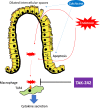Acute Colchicine Poisoning Causes Endotoxemia via the Destruction of Intestinal Barrier Function: The Curative Effect of Endotoxin Prevention in a Murine Model
- PMID: 31312993
- PMCID: PMC6943411
- DOI: 10.1007/s10620-019-05729-w
Acute Colchicine Poisoning Causes Endotoxemia via the Destruction of Intestinal Barrier Function: The Curative Effect of Endotoxin Prevention in a Murine Model
Abstract
Background: Colchicine binds to intracellular tubulin and prevents mitosis. Colchicine is also used as an anti-inflammatory drug. Meanwhile, excess administration of medication or accidental ingestion of colchicine-containing plants can cause acute colchicine poisoning, which initially results in gastrointestinal effects that may be followed by multiorgan dysfunction. However, the mechanism of colchicine poisoning remains unclear, and there are no standard therapeutic strategies.
Aims: We focused on intestinal barrier function and attempted to reveal the underlying mechanism of colchicine poisoning using an animal model.
Methods: Colchicine was orally administered to C57Bl/6 mice. Then, we performed histopathological analysis, serum endotoxin assays, and intestinal permeability testing. Additionally, the LPS-TLR4 signaling inhibitor TAK-242 was intraperitoneally injected after colchicine administration to analyze the therapeutic effect.
Results: We observed villus height reduction and increased numbers of apoptotic cells in the gastrointestinal epithelium of colchicine-treated mice. Both intestinal permeability and serum endotoxin levels were higher in colchicine-treated mice than in control mice. Although colchicine-poisoned mice died within 25 h, those that also received TAK-242 treatment survived for more than 48 h.
Conclusion: Colchicine disrupted intestinal barrier function and caused endotoxin shock. Therapeutic inhibition of LPS-TLR4 signaling might be beneficial for treating acute colchicine poisoning.
Keywords: Colchicine; Endotoxin; Intestinal barrier.
Conflict of interest statement
The authors have no conflicts of interest regarding the contents of this article.
Figures





References
Publication types
MeSH terms
Substances
LinkOut - more resources
Full Text Sources
Research Materials
Miscellaneous

